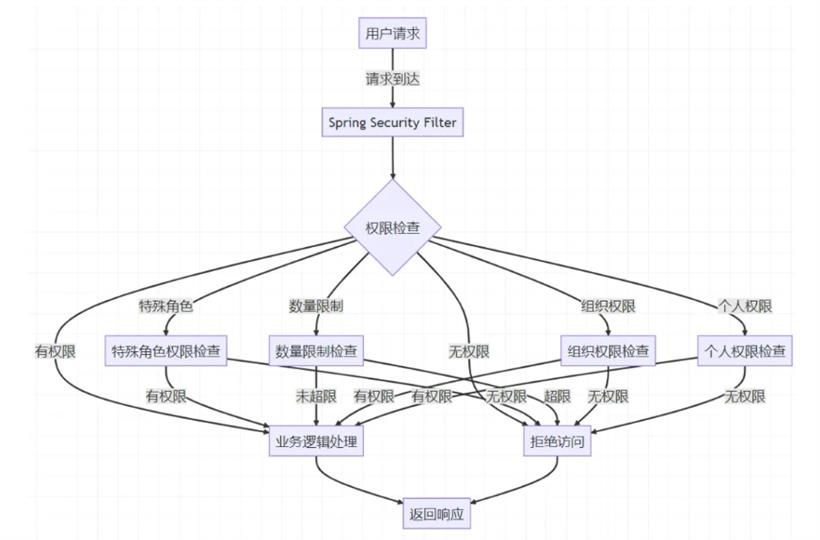- 联系我们
- duidaima.com 版权声明
- 闽ICP备2020021581号
-
 闽公网安备 35020302035485号
闽公网安备 35020302035485号
 闽公网安备 35020302035485号
闽公网安备 35020302035485号
权限审计: 所有权限的授予和使用都应该被记录和审计,以确保系统的安全性和合规性。

组织表(Organizations)
| 字段名 | 数据类型 | 描述 |
|---|---|---|
| organization_id | INT | 主键,自增 |
| name | VARCHAR | 组织名称 |
| parent_id | INT | 父组织ID,用于层级关系 |
| description | TEXT | 组织描述 |
用户表(Users)
| 字段名 | 数据类型 | 描述 |
|---|---|---|
| user_id | INT | 主键,自增 |
| username | VARCHAR | 用户名 |
| password_hash | VARCHAR | 加密密码 |
| organization_id | INT | 所属组织ID |
| VARCHAR | 电子邮件 | |
| created_at | DATETIME | 创建时间 |
| updated_at | DATETIME | 更新时间 |
角色表(Roles)
| 字段名 | 数据类型 | 描述 |
|---|---|---|
| role_id | INT | 主键,自增 |
| name | VARCHAR | 角色名称 |
| description | TEXT | 角色描述 |
权限表(Permissions)
| 字段名 | 数据类型 | 描述 |
|---|---|---|
| permission_id | INT | 主键,自增 |
| name | VARCHAR | 权限名称 |
| description | TEXT | 权限描述 |
角色权限关联表(Role_Permissions)
| 字段名 | 数据类型 | 描述 |
|---|---|---|
| role_id | INT | 角色ID,外键 |
| permission_id | INT | 权限ID,外键 |
用户角色关联表(User_Roles)
| 字段名 | 数据类型 | 描述 |
|---|---|---|
| user_id | INT | 用户ID,外键 |
| role_id | INT | 角色ID,外键 |
组织权限关联表(Organization_Permissions)
| 字段名 | 数据类型 | 描述 |
|---|---|---|
| organization_id | INT | 组织ID,外键 |
| permission_id | INT | 权限ID,外键 |
| limit | INT | 允许的操作数量限制 |
import java.lang.annotation.ElementType;
import java.lang.annotation.Retention;
import java.lang.annotation.RetentionPolicy;
import java.lang.annotation.Target;
@Target({ElementType.METHOD, ElementType.TYPE})
@Retention(RetentionPolicy.RUNTIME)
public @interface PermissionRequired {
String[] value();
}
定义角色注解(@RoleRequired)import java.lang.annotation.ElementType;
import java.lang.annotation.Retention;
import java.lang.annotation.RetentionPolicy;
import java.lang.annotation.Target;
@Target({ElementType.METHOD, ElementType.TYPE})
@Retention(RetentionPolicy.RUNTIME)
public @interface RoleRequired {
String[] value();
}
定义数量限制注解(@LimitRequired)import java.lang.annotation.ElementType;
import java.lang.annotation.Retention;
import java.lang.annotation.RetentionPolicy;
import java.lang.annotation.Target;
@Target({ElementType.METHOD, ElementType.TYPE})
@Retention(RetentionPolicy.RUNTIME)
public @interface LimitRequired {
String value();
}
使用示例@RestController
@RequestMapping("/api")
public class ApiController {
@PermissionRequired("READ_DATA")
@GetMapping("/data")
public ResponseEntity<?> getData() {
// 方法逻辑
}
@RoleRequired({"ADMIN", "MANAGER"})
@PostMapping("/config")
public ResponseEntity<?> updateConfig() {
// 堆代码 duidaima.com
// 方法逻辑
}
@LimitRequired("REQUEST_LIMIT")
@GetMapping("/request")
public ResponseEntity<?> makeRequest() {
// 方法逻辑
}
}
在这个示例中,getData 方法需要用户拥有 READ_DATA 权限,updateConfig 方法需要用户拥有 ADMIN 或 MANAGER 角色,而 makeRequest 方法需要检查 REQUEST_LIMIT 类型的数量限制。代理(Proxy): 代理是AOP框架创建的,它包裹了目标对象,并在执行连接点之前或之后执行通知。
import org.aspectj.lang.annotation.Aspect;
import org.aspectj.lang.annotation.Pointcut;
import org.aspectj.lang.annotation.Before;
import org.springframework.stereotype.Component;
@Aspect
@Component
public class PermissionAspect {
@Pointcut("@annotation(permissionRequired)")
public void permissionPointcut(PermissionRequired permissionRequired) {}
@Before("permissionPointcut(permissionRequired)")
public void checkPermission(JoinPoint joinPoint, PermissionRequired permissionRequired) {
// 获取当前用户
User currentUser = SecurityContextHolder.getContext().getAuthentication().getPrincipal();
// 检查用户是否拥有所需的权限
for (String permission : permissionRequired.value()) {
if (!permissionService.hasPermission(currentUser, permission)) {
throw new AccessDeniedException("Access Denied: No permission to perform this operation.");
}
}
}
// 其他方法,如角色检查、数量限制检查等
}
组织权限检查public boolean hasOrganizationPermission(User currentUser, String permission) {
// 查询数据库,检查用户所属组织是否有权限
}
个人权限检查public boolean hasUserPermission(User currentUser, String permission) {
// 查询数据库,检查用户是否有权限
}
数量限制检查public boolean isLimitExceeded(User currentUser, String limitType) {
// 查询数据库,检查是否达到数量限制
}
特殊角色检查public boolean hasSpecialRole(User currentUser) {
// 查询数据库,检查用户是否拥有特殊角色
}
综合检查逻辑@Service
public class UserService {
@Autowired
private UserRepository userRepository;
public User getUserById(Long userId) {
return userRepository.findById(userId).orElse(null);
}
public Set<String> getUserPermissions(Long userId) {
User user = getUserById(userId);
if (user != null) {
Set<Role> roles = user.getRoles();
Set<String> permissions = new HashSet<>();
for (Role role : roles) {
permissions.addAll(role.getPermissions());
}
return permissions;
}
return Collections.emptySet();
}
// 其他用户相关业务逻辑
}
角色权限服务(RoleService)@Service
public class RoleService {
@Autowired
private RoleRepository roleRepository;
public Role getRoleById(Long roleId) {
return roleRepository.findById(roleId).orElse(null);
}
public Set<String> getRolePermissions(Long roleId) {
Role role = getRoleById(roleId);
if (role != null) {
return role.getPermissions();
}
return Collections.emptySet();
}
// 堆代码 duidaima.com
// 其他角色相关业务逻辑
}
权限检查服务(PermissionService)@Service
public class PermissionService {
@Autowired
private UserService userService;
@Autowired
private RoleService roleService;
public boolean hasPermission(User user, String permission) {
if (user == null) {
return false;
}
Set<String> userPermissions = userService.getUserPermissions(user.getId());
return userPermissions.contains(permission);
}
public boolean hasRole(User user, String role) {
if (user == null) {
return false;
}
Set<Role> userRoles = user.getRoles();
for (Role userRole : userRoles) {
if (userRole.getName().equals(role)) {
return true;
}
}
return false;
}
public boolean isLimitExceeded(User user, String limitType) {
// 实现检查用户或组织是否超出了操作数量限制
// 这可能涉及查询数据库中的计数器或使用缓存
return false;
}
// 特殊角色检查
public boolean hasSpecialRole(User user) {
// 实现检查用户是否拥有特殊角色
return hasRole(user, "ADMIN"); // 示例:假设"ADMIN"是特殊角色
}
}
业务逻辑实现说明安全性: 通过细致的权限控制,可以确保系统的安全性,防止未授权访问。
安全性依赖: 系统的安全性高度依赖于权限控制的实现,任何实现上的漏洞都可能导致安全风险。